Mother nature has been inconsiderate to skiers on both coasts this year. Call it a weather cycle, global warming, a vast right or left wing conspiracy (depending on the political persuasion), it was evident. As the weather phenomenon coined “The Pineapple Express” shed vast amounts of warm, humid air on an almost straight East-to-West line in the mid-latitudes of North America, mountain ranges on both coasts became bereft of their annual snowcaps, with only a relatively narrow central band of snow from California to Colorado, along with rains of diluvial proportions in what are normally desert areas.
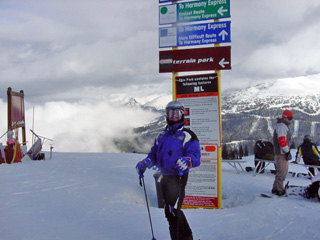
|
|
Author Lou Botta at the top of the Whistler Gondola.
|
The result was bare mountains where before there was snow, but now lost revenue for the ski areas, and depressed skiers clinging to the hope of mid- and late-season storms. In areas where the altitude made possible below-freezing temperatures, there was snow, but below that, green patches with eroded surfaces. Still, the resilient nature of the earth was evident as this petulant weather cycle began to dissipate not too soon. Such was the case during our recent nine-day trip to Whistler-Blackcomb, British Columbia.
Our experience at Whistler was limited because of the conditions. Less than half the mountain was skiable. Before starting to cry, consider that this means the skiable acreage was still more than twice that of Breckenridge and about four times that of Deer Valley. In my book, I follow the adagio “if life gives you lemons, make lemonade.” We made the best of it and had an unbelievably great time. Still, we have to stand and consider that if we had a blast as it was, imagine how it would have been if the entire mountain was skiable. Well, we’ll be back to see…
To understand Whistler, one has to make a paradigm shift. It’s not the number of trails, which number over two hundred. It’s not the mountains, which include three glaciers. It’s not the vertical, which is over five thousand feet; It’s not acres of skiing terrain (over eight thousand). We are talking about square miles of bowls, over 200 trails, terrain parks, and a massive combination of several villages with perhaps a hundred restaurants, over a hundred hotels or guest houses, dozens of bars, numerous nightclubs, over ten thousand year-round residents, mountain outfitters, innumerable ski dealers, physical therapists and orthopedic surgeons to complete the list. This link has a comparative depiction of Whistler-Blackcomb compared to other large North American resorts. Deer Valley and Aspen seem bunny slope-sized compared to the combined acreage of Whistler.
Whistler is the crown jewel of Intrawest, owner or manager of numerous resorts in North America that includes Copper Mountain and Winter Park in Colorado; Mount Tremblant, Quebec; Stratton, Vermont; Snowshoe, West Virginia; Mammoth, California, and many others. I viewed Whistler with a sense of ambivalence: awe at the gargantuan size of the resort, admiration for the amenities and resources; and as a homeowner at an Intrawest resort, fear that Snowshoe could someday become so impersonal. Whistler can be indeed an overwhelming place because of its sheer magnitude. And it’s about to get much larger as the site for the 2010 Winter Olympics, along with Vancouver. There is construction virtually everywhere, with more upscale hotels, more condos, and more mansions.
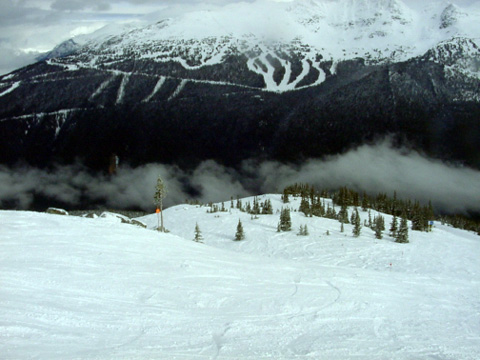
|
|
View of Blackcomb Mountain and Seventh Heaven Express terrain from Whistler Bowl.
|
The real estate values on the mountain are impressive: condos start at half a million, with houses in the two million mark. This is only going to get more expensive as the Olympics approach. An interesting facet of the market, still to be seen as a popular option in the Mid-Atlantic, is fractional ownership. Homes went for sale at one-fifth share, one-quarter share, one-third share, etc. I guess at the prices quoted, it is about the only way that second-home ownership is available to the middle class. I met some people who had purchased real estate on that system and it seemed to make sense.
My first lesson for the future was to do some homework prior to my next visit. Meeting other people staying elsewhere on the mountain can be a chore. Although the resort talks about a simple village concept, the “village” has grown into a city-size development and hotels and condos can be miles from one of the villages… yes, there are three villages: the main village at Whistler, itself subdivided into two main areas, the village at Blackcomb also called upper village, and Creekside, almost two miles down the road and the oldest part of the resort. Between these, there are countless condo complexes, hotels and businesses.
Despite the thousands of rooms at Whistler, most of the hotels use the resort’s central reservation system, so their particular hotel numbers are not published and require calling ahead and asking for the phones, or contacting the parent operator of the particular hotel, such as Marriott, Fairmont, Four Seasons, etc. Another confusing part was the shuttle lines. Yes, very effective and timely, but confusing for the newcomer. There are numerous bus shuttles. Some are free; some are fee-driven ($1.50 Canadian). Some follow different routes between day and night. Some shuttles combine routes at night. Worse yet, some shuttles stop at different hours of the night and one can become stranded, two miles from the hotel, and a half mile the opposite direction from the nearest taxi station. My best recommendation is to do some thorough homework on the web site (all bus routes and locations are published on the web), know which route goes by one’s destination as well as other people in the group if they are staying at another place. Rental cars? Not worth it in my opinion. Parking is a pain, and the locations of the free parking areas are away from the villages. The free shuttles to the parking areas stop at night. If parking at a hotel, expect hefty parking fees.
Our plane from Philadelphia stopped at Minneapolis-St Paul prior to heading off to Vancouver. Uneventful and pleasant, although taking up almost 10 hours of the day between flights and ground time. It pays to upgrade on international flights like these, as the Northwest first class lounges at Minneapolis are a dream, with a variety of food and beverages. Besides, as everyone in the back is having soggy peanuts and surly service, the folks in front are having both breakfast and lunch. With the three-hour change in time zones, we arrived in Vancouver in the early afternoon.
Landing in Vancouver gave us a full view of the majestic, snow-capped mountains to the East, the well-sheltered harbor, and the fjords into which we would soon be traveling on the way to Whistler. The customs formalities were uneventful, quick processing and entering the terminal, and then right off the left side of the international arrivals exit, the desks for the Whistler transport services. We had booked our shuttle on Perimeter Lines. Perimeter uses luxury coaches costing $65 Canadian (about US $54 each way). There are several other services using stretched limousines, Hummer Limousines, SUVs, and even a helicopter service. For a price, that is…
Traveling to Whistler on the bus, try to take a seat on the left side of the bus. The view is simply spectacular. The highway follows a fjord as it moves up the terrain prior to going into the mountains. The bus made numerous stops prior to our destination, the Marriott Residence Inn. The Marriott property is located in a ski-in, ski-out location on Blackcomb’s Merlin’s trail under the Wizard Express quad. Ski-in and out… if there was snow. The trail was almost bare when we arrived. Weeks of heavy rains had washed out most of the snow, and it was only the efforts of the dedicated groomers, moving snow from the higher areas every night, that there was a semblance of snow in the lower elevations. The Marriott has a large outdoor pool, two large hot tubs, its own ski rental place with updated gear, and is one of the few places in the resort that offers daily complimentary breakfast. Best of all, it was nice to stay in a suite with a full kitchen and fireplace instead of a standard room.
Despite the fact that the Residence Inn has its own ski rentals, we had made reservations for demo skis at Affinity Rentals, given that I wanted to demo the Volkl Supersport 6. By the way, it turned out to be a wonderful all-mountain ski, but a little lacking on a deep powder day (68 mm waist). There are a plethora of Affinity locations throughout Whistler. There are also SkiCan, Salomon Store, and others. Again, most reservations can be made online.
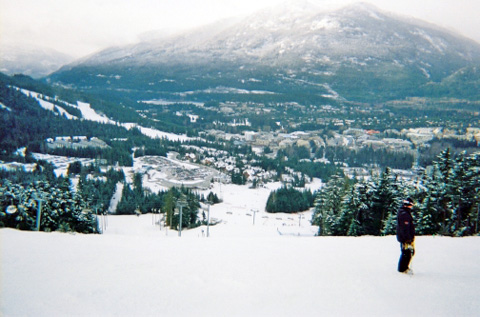
|
|
View of Whistler Village from Blackcomb. Whistler runs are to the lower left.
|
The resort caters to a wide and diverse clientele. Millionaires mingle at the bars with ski bums. Corporate magnates in their 6 million dollar slopeside mansions frequent the same watering holes as college kids on vacation. Yet, the ambiance is definitely upscale, trademark Intrawest. To my pleasant surprise, many of the finer restaurants took reservations and gave you a window after which they would cancel the reservation. I wish Snowshoe’s restaurant community adopted this practice. The restaurants also range in price and food (my listed prices included wine, and note that as of last week, 1 US dollar = 1.20 Canadian), from the numerous healthy fast food-type variety such as the Pita Place, where we were able to dine in the intermezzo between two nightclubs, averaging $8 Canadian, to the portentous and opulent such as Araxis, where the eight-course, eight wine-bottle dinner bill came to $225 Canadian per person - and worth every penny. In the middle, three sushi places, each competing for quality, averaging in the $25 Canadian per person, a Japanese steakhouse with wonderful cuisine, and several other wonderful restaurants among which we could only sample a few; Barefoot Bistro’s classical European faire (average $40 per person), and, in the Upper Village, Thai One On’s exquisite Thai food ($40 Canadian pp) and Monk’s Grill ($35 Canadian pp). It is worth mentioning that McDonald’s has made its sad and unfortunate appearance at Whistler, although in a far out-of-the-way place where we seldom went. It was also obvious not many other people frequented that venue either.
Our first dinner was at the Mongolie, a Mongolian Barbecue restaurant where one makes his own concoction with meats that include venison, bison, turkey, several types of fowl, and a myriad of vegetables and sauces, and then the mélange is cooked on a concave grill top. Mongolian Barbecue is a familiar staple in many military officer clubs and we knew what to expect. As the price is per uncooked ounce, it can range from $10 to $50 Canadian. Overall, one can eat porcine proportions for about $25 Canadian.
On a related subject, the après-ski locations were impressive. The Garibaldi Ski Lift Company, above the Whistler Gondola offices, is one of the most popular destinations. A true North American sports bar, with impressive-sized projection screens, football game on, good pub food, and a truly great ambiance, ski-boot wearing crowd tired from the slopes having a good time. The Longhorn was another venue with a similar clientele, almost next door to Garibaldi’s. Across the plaza, the Dubh Linn, always full, always lively, but with a more showered, Polo and Izod-clad group. All were friendly, all reasonably priced, all worth visiting.
Next came the ski lift tickets. To my grateful surprise, the fact that I was a season ticket holder at Snowshoe gave me an automatic 50 percent off at Whistler, which at $72 Canadian full price translated into only $30 US per day. Not bad. The only wicket was having to go by the Guest Services office to get the reduced rates, but well worth it.
When we got there, it was obvious the resort had made everything possible to validate the claim that the entire vertical length of the mountain was skiable … barely. For the first three days, skiing top to bottom would have meant needing a new base on the skis upon return. However, once above the three thousand foot level, it was winter wonderland. Our first day was spent at Whistler. Whisked to the Roundhouse Lodge aboard the Whistler Gondola’s 20-minute trip, and following a nice cup of hot chocolate, we began the fun.
With all that terrain, Whistler can be overwhelming. In addition, getting lost in a bowl or down a glacier crevasse can be dangerous if not outright life threatening. Some of the bowls such as the new Flute Bowl and Boomer Bowl, can easily lead the skier away from the trails leading to recovery, with the possibility of getting lost or perhaps having to endure several hours of cross-country skiing uphill. I would recommend initially using a guide. Although our group had its own guides, the resort offers complimentary guide service at different hours of the day. The complimentary guide service is broken by experience level to satisfy the beginner all the way to the expert.
Roundhouse, at the top of the Whistler Gondola, is sort of the Grand Central of Whistler’s upper elevation. The school meets there, the complimentary guided tours meet there, and the huge cafeteria serves there. From Roundhouse to the right, one can connect down several green, blue and single black runs to Franz’s Chair, a slow triple that ends just above Roundhouse, providing about a thousand foot vertical, or one can continue down approximately another thousand feet vertical to Big Red, a high-speed detachable quad that parallels and ends almost next to the top of Franz’s. From the top of Franz or Big Red, one can either return to the Roundhouse on the left or turn right and proceed to either the double T-Bars up the Whistler Glacier or take the Peak Chair to the top of Whistler. This last option opens the road to both front and back glacier bowls. As far as the T-bars, we wondered why there was such an outmoded apparatus on an otherwise upscale resort; the answer was that these T-bars are actually built on the glacier itself and they are repositioned every year if needed, to compensate for the movement of the glacier.
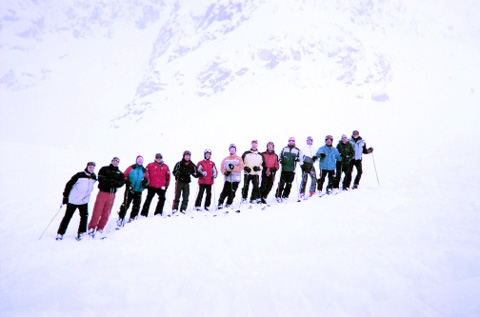
|
|
Group photo at the top of Glacier Bowl.
|
To the left of Roundhouse one can take an endless variety of trails to three high-speed detachable chairs: Garbanzo, Emerald and Harmony. The Garbanzo chair site is also next to the Gondola’s mid-point and normally the center of school operations and easier terrain. However, until late in our stay this entire terrain was unusable due to the lack of snow. Up from Garbanzo and to the left was the Emerald Chair. With mainly greens and blues feeding it, it was a great morning warm-up and provided variety. The Harmony Express ended not far from the Whistler Peak Chair, and it opened up miles of advanced, expert, and “Kamikaze” expert trails, bowls and glaciers. Both the Harmony Express and the Whistler Peak Chair connected through the ridgeline to one of the most enjoyable advanced blue trails I’ve ever seen, the Saddle. This last trail went down a glacier bowl and due to its open terrain, it is up to the skier to make it either a challenging or an easy intermediate run. To the side of the Saddle trail, there were both single blacks and double blacks down the Glacier Bowl. Additionally, from the Whistler Chair, one could ski single and double blacks down Whistler, West and Bagel Bowls. The Harmony Express, on the other hand, would open several more bowls such as the Flute, Sun and Boomer Bowls. Harmony would prove to be our most popular chair. Polka-dotted among all of these chairs were rest lodges, restaurants, and snack bars. Getting a cup of hot chocolate was very easy.
Conditions above approximately three thousand feet were awesome. I have to say that as an Eastern skier, it took some time get used to the deep snow in the bowls. However, the variety of terrain means one can practice until the confidence level builds up and by the end of the third day I was comfortable on most of the terrain. I am no Kamikaze, however, and took my time acclimating to the conditions.
Our initial warm-up foray was down Franz, a long, two thousand foot vertical blue run that can either connect to Franz Chair or Big Red. We decided to warm up by going all the way down to the quad, and about five hundred feet above Big Red, we hit the freezing level and everything turned to slush mixed with rocks. That was the last time we went there that day. Next we went up Big Red to more of the trails on Franz, all of them with excellent conditions. Then we hit the Peak Chair, down the Saddle, on to the T-bar for more of the bowl, up the Peak Chair and then off to the Bagel and West bowls. We did one trail down Harmony before having to head back home. We downloaded at the Whistler Gondola to make the trip back home.
The next day was Blackcomb’s turn. Blackcomb Mountain’s lift system is not as organized as Whistler, so it pays to review the ski trail map before embarking on the day’s agenda. One gondola and one high-speed with a bubble serve the mountains from the base, one from the Upper Village, one from Whistler Village. They cross and go in opposite directions. Then there are several other chairs that serve particular areas of the mountain, including the Blackcomb Glacier. More on that later.
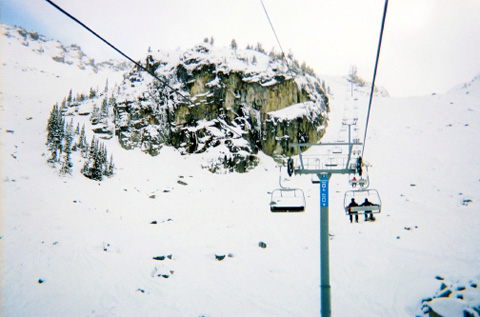
|
|
On the Glacier Chair up to Blackcomb Glacier.
|
Our experience in Blackcomb was limited by the conditions, as more than half of the mountain was not skiable. Blackcomb’s terrain is also quite varied and offers in itself a wonderful experience for all experience levels. For pleasure-cruising blues, the Seventh-Heaven chair is accessible through the Solar Coaster Express, which feeds off the Whistler Express high-speed with bubble from the base. The terrain surrounding Seventh Heaven is a marvel of the relationship of terrain, good design, excellent grooming, and good natural snow. I think there were about seven trails that provided our morning warm-up, with no lines, in rapid succession.
The true wonder of Blackcomb Mountain was its advanced terrain. The Blackcomb glacier was a marvel. The ascent was tortuous, though. First, we took the Excalibur gondola up to the base of the Excelerator Express high-speed chair. Get on the Excelerator and get off the top only to ski down to the Glacier Express chair. Take the Glacier Express, get off at the top, ski down to the Showcase T-Bar, get on the T-bar, ride to the top, take off your skis, hike about 150 feet uphill in knee-deep snow, walk over the ridge on a foot trail barely two feet wide, and then enjoy the view… But what a view!
The scenery from the top of the Glacier is unbelievable. Spectacular. Reminded me of the views at the side of the Matterhorn in Switzerland during my previous trip to Zermatt. Under our feet, almost vertical, was the sight of a living glacier, although now succumbing to the effects of global warming. To the horizon, the majestic views of still more glaciers. Almost a mile away, the glacier bowl edge curving away and providing a gradual descent for those who want to take an easier route to the valley.
The glacier conditions were awesome, and even more so on our fifth day when almost two feet of snow fell on top of the mountain. For me, I took it slow on the way down, not as much on account of the sheer descent but in awe and respect for the sheer beauty and magnitude of the place. Every two or three hundred feet we felt compelled to stop, admire the glacier valley below, and thank the heavens for being alive to enjoy such scenery. The glacier bowl ends in a narrow valley which connects to a long, interminable, several miles-long green trail, which goes back to the base of the Excalibur chair.
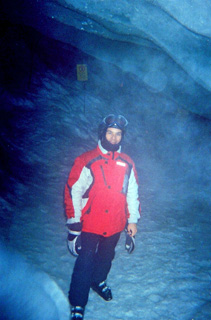
|
|
Inside the Glacier Cave at Blackcomb.
|
The glacier had yet another surprise for us. Just below the top of the Glacier Express chair, tucked away from curious eyes on top of a ravine, was a glacier cave. You had to know it was there to go there, I guess. Our guide took us to the cave telling us it would be one of the highlights of the run and he was totally correct. The entrance was marked with the usual liability waiver signs, but it wasn’t roped off. Entering the ice cave was through an opening about six feet tall by two feet wide, down a chute about ten feet long. Inside, the cave widened to hall-size proportions, perhaps sixty feet long by thirty feet wide and ten feet tall. Despite being partially cut off from light, the cave was lit by the blue aura of the glacier ice. It was a wondrous experience, enhancing our respect for the sublime beauty of nature. As in the glacier run, one was partially paralyzed with awe. An amazing sight. Then it was skiing down the Horstman Glacier and admiring the beauty of the village below.
On the evening of the fourth day, the freezing level descended to the village base and it started snowing everywhere. The morning of the fifth day was a winter wonderland. The temperature stayed low throughout the week, allowing the snow guns to cover the low and mid-altitude runs with copious amounts of snow, augmenting the natural snow. It became possible then to ski down all six thousand feet of the mountain, allowing for unbelievable skiing.
With the snows of the latter part of the week, we had to see for ourselves how the Whistler conditions had changed. We returned to the Peak Chair and this time, Bagel Bowl was in prime condition. Same as the West Bowl. Some of our group took to the double-blacks flanked by monster boulders. The day was a total success and a memorable experience. As in the days prior, we were finally able to ski down to the village and take advantage of some of the best terrain in North America.
Nine days came and went in what appeared to be a weekend. Our bus came directly to the hotel… at 2 a.m. (Ouch!). Outbound processing through Vancouver International is a cinch. One preclears US Customs in Canada, a relatively simple procedure. For business and first class passengers, the Alaska Airlines lounge gives reciprocal privileges to most US airlines, providing a very comfortable pre-departure rest with all the amenities. The flight through Houston took much less time than expected, primarily due to the now-normal jet stream headed the same way we were. On departure, we were able to take a view of the exquisite scenery of Vancouver and its harbor. The plane then veered South towards Seattle and then turned East, and in the abnormally clear weather of the Pacific Northwest, it was obvious the Upper Northwest is headed for a summer drought. As a retired USAF pilot I clearly remember the Cascades being heavy snow country. Now, the usually copious snows on top of Mt Baker, Glacier Peak, Mt Rainier, Mt St Helens, and Mt Adams seemed thin and fragile. This is corroborated by the angst of Northwest skiers that were flocking to Whistler with sad stories about the conditions in the Washington and Oregon ski areas this year.
We are going back to Whistler, although next time we will check the weather more carefully and do more homework as to where everyone is staying to make sure we’re not at opposite ends of town. There is so much variety in the town to appeal to any taste. Although overwhelming at first, Whistler became more familiar as time went by, and despite only being able to reconnoiter about a third of the town, villages and shopping areas, we have a good start. Can’t wait to return next year…
While actually born in the tropics (Cuba), Lou grew up in New England and went to College in Vermont, where he initially took up skiing. He then embarked on a twenty-two year Air Force piloting career that took him to over 50 countries. He has skied in Europe and America (both North and South). His second career as a senior officer with the Federal Government spanned thirteen years and in 2010, Lou retired to pursue a more leisurely life style.
